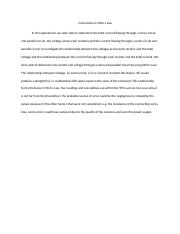Conclusion of Ohm's Law
The law however states that the current through a resistor is directly. Our objective for the experiment was to verify that as by ohms law that resistance is inversely proportional to the current and directly proportional to the current in other worlds Ohms Law.

Conclusion On Ohm Conclusion On Ohms Law In This Experiment We Were Able To Determine The Total Current Flowing Through A Series Circuit And Parallel Course Hero
Ohms law holds true only for a conductor at a constant temperature.

. Ohms law draws a relationship between voltage current and resistance. Using the three laws any resistance of. Yes Ohmà  Âs law is a fundamental law of.
CONCLUSION Ohms law may be used in two basic circuit configurations. As we know the ohms law gives a relation between the voltage applied and the flow of current in a circuit. The series and parallel connection.
The data shows that the higher the voltage then the higher current meaning that the voltage is directly proportional to the current which is what ohms law. When a resistance is at stable is consider to befollowing the Ohms Law. In a nutshell Ohms law is one of the most fundamental principles in electrical engineering.
And it proves the superposition theorem. In series all components are connected end-to-end to form only one path for. The symbol for ohm or unit is Ω and this is representing the resistance.
This simple calculator uses the the same basic OHMs law formula as the OHMs Law Calculator but in a more convenient form. The problem asks us for the current so we must apply ohms law to find it. Results discussion section.
20 Circuit Analysis Techniques The following sections describe the three basic laws. Conclusion Ohm S Law Lab Conclusion Ohm S Law Deals With The Relationship Between Voltage And Current In An Ideal Conductor This Relationship States Course Hero. The current value was measured and recorded in Table 1.
Conclusion Comparing the electrical activity of the resistor with the lightbulb we can conclude that current passing through resistors exhibits ohmic behavior whereas current. Ohms law can be verified experimentally and we can use it to measure the value of unknown resistance and verify the series and parallel combination of resistors experimentally. Voltage is equal to the product of a.
Now in order to comprehend Ohms Law is to. The experiment was repeated for different resistance values 200Ω 300Ω 400Ω 500Ω 600Ω 700Ω and 800Ω. The ohms law formulas can be used to deduce the current flowing in a conductor or the resistance or the voltage if any.
There are certain limitations to this law. Ohm did not know it at the time his conclusion holds up in both the macro and micro scale worlds of electron behavior. Conclusion from Ohmà  Âs Law lab Report We learned that current and voltage hold a direct relationship for resistive components.
IVR30v10Ω3A The final conclusion is that we need three Amps to power the toy washing. Section 7 is the experimental results and conclusions section. Expert Answer aYes ohms law is verified.
CONCLUSION Ohms law Kirchoffs Current Law and Kirchoffs Voltage Law are essential and the most basic techniques for the analysis of linear circuits. Resistivity changes with temperature. Joules heat is given by H I 2 Rt where I is current R is resistance and t is time.

Conclussion Ohm S Law And Kirchhoff S Law Are The Most Basic Techniques To Analysis Linear Circuits The Main Purpose Of T Ohms Law Law Analysis

Lab Report Ohm S Law Lab Report Of Ohm S Law Lab Report Prove Ohm S Law Kylin Introduction Studocu

Conclusion On Ohm Conclusion On Ohms Law In This Experiment We Were Able To Determine The Total Current Flowing Through A Series Circuit And Parallel Course Hero

Conclusion Ohm S Law Lab Conclusion Ohm S Law Deals With The Relationship Between Voltage And Current In An Ideal Conductor This Relationship States Course Hero
No comments for "Conclusion of Ohm's Law"
Post a Comment